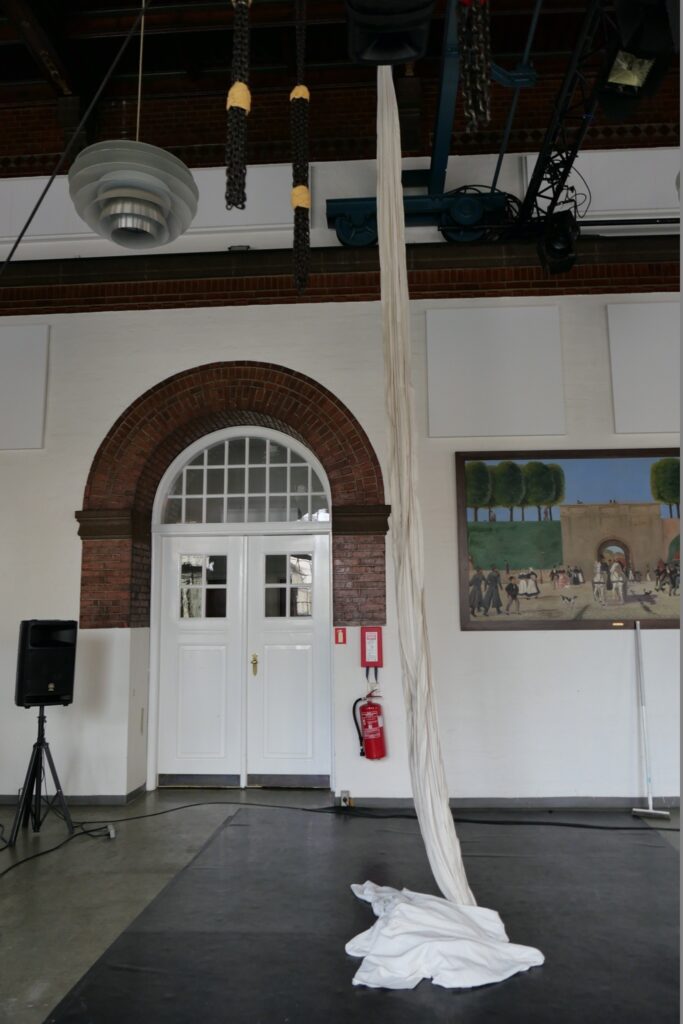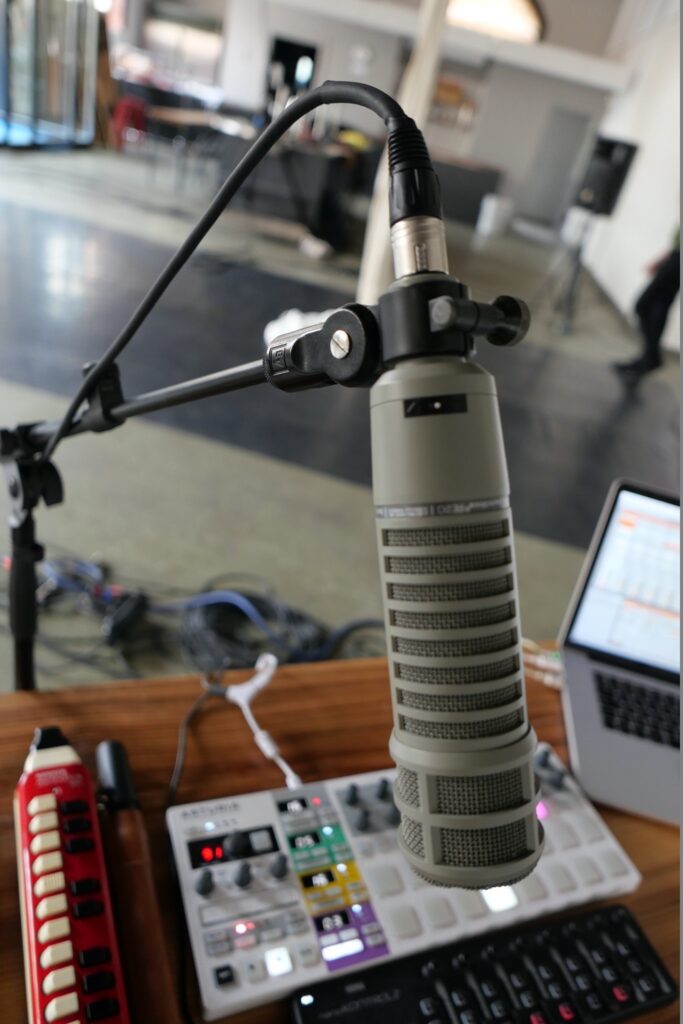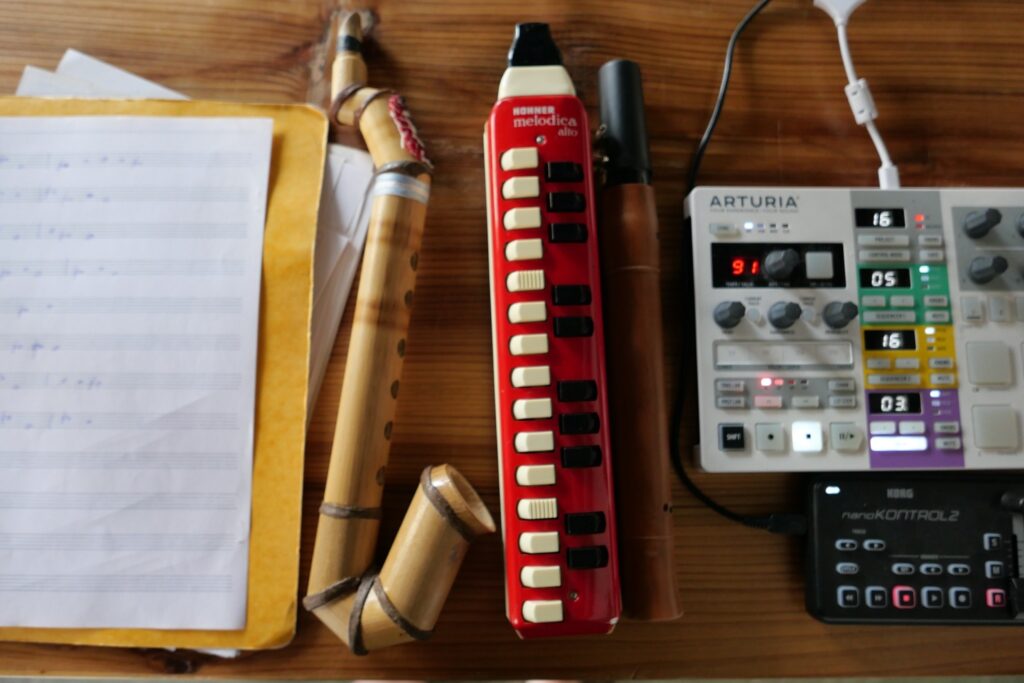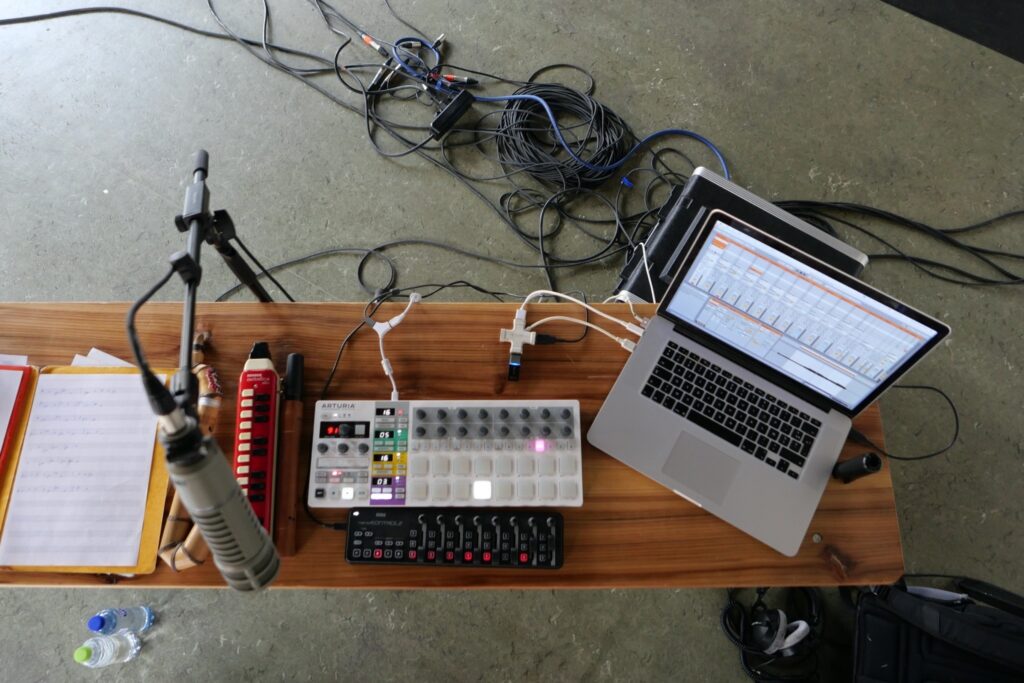French trapeze artist Noémie Deumié and the Belgian musician/composer Kwinten Mordijck worked together from 10 till 23 August 2021 in Copenhagen (Denmark), under the wings of Metropolis-KIT. This is their logbook.
Starting points
We had several calls and emails to learn from each other and exchange about what we wanted to research during the residency.
Noémie had the wish to share the stage and react to someone playing live music, and find a duet performing experience. Kwinten was not that interested in this option, he was more attracted by composing for someone. We decided to go with that and try to give to music a spatial dimension that Noémie could interact with.
So we went with the idea of having several loudspeakers. This way we could experiment with spatialising the music, which means mixing the music for more than just a stereo-setup. This means that we could have for example an instrument in every speaker which would make the listener feel surrounded by “musicians”.
But this could also mean that the music could travel from speaker to speaker, which would add an extra “movement” in the music. We were interested in how this would affect and relate to a body in motion. We exchanged videos of sound spatialized works that we found online to define what we were looking for with movement and music.
Our mentor was Dave Black, a sound designer artist that came twice to see where we were, to give us advice on technical setups and on how to exchange and share our artistic worlds. We also exchanged messages and zoom when he was unable to come. He suggested starting with the most simple way to achieve our goals, so we decided to start with a setup of five speakers.
Noémie wanted to explore the duality of internal versus external relating to her movements. A part of our research would also include how to go from internal to external without losing the intimacy of the proposition and the internal strength.
First days
We went to a space and we tried this setup: a quadraphonic setup and a speaker above the silks in the center.
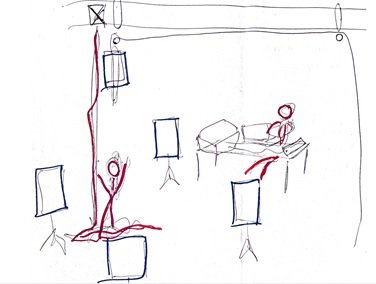
Because the spatial setup was new to Kwinten we decided to start to work with “Mother”, one recorded song from Kwinten that Noémie had already heard: https://kwintenmordijck.com/en/projects/circus-without-circus-copenhagen.
The song “Mother” consists of four baritone saxophones playing a similar melodic line in harmony to each other, a high ‘shiny’ soloing chalumeau (pitched up an octave) and a few dense saxophone loops. Kwinten spatialized the song by letting one saxophone start in one speaker and let this one saxophone move to the next saxophone after which the other three saxophones would start in the first speaker. He experimented with this moving around of the ‘saxophone player’ and noticed this could use more time to build up compared to the stereo setup, which, looking back, seems obvious, but we needed this first try to learn, hear and feel this and to understand the impact of spatial movement on the composition. The spatial movement of sound is an extra variable (like pitch, rhythm, timbre, …) for composition. When the four saxophones were in the four seperate speakers on the floor, the ‘shiny’ chalumeau would start in the speaker above the silks, which would have a surprising effect on the listener because of the change of direction (sound coming from above). To end this experiment with mother he used the dense saxophone loops to experiment with faster turning movements (long notes traveling fast in a circle around the listener). With this ‘re-arrangement’ of the song for a spatial setup we tried to see how it would affect Noémie’s improvisations on the silks.
She was in the center of the speakers, where all the layers of music were melting. It gave her a really surrounded sensation and it felt nice. She felt a lot of new impulses and inputs of movement, of opening. It helped her choose clear directions when the sound was separated. We did these improvisations a few times, to try to understand how all these parameters could match, because it was a lot of new information. For example, by adding this movement of Noémie, there was a need to let the music even buildup longer. Just like the spatial movement, Noémie’s movements were an extra parameter influencing the buildup of the music.
While Noémie reacts to the position of the sound and this can create interesting movements and is valid on its own, it’s not always as obviously clear for an audience member we think. This is not necessary, but it’s something to keep in mind.
Of course the obvious “there’s one saxophone in that corner and Noémie points towards it” is very clear, but for example when a dense sound is turning at a certain speed and Noémie tries to follow, the audience doesn’t necessarily feel/hear/see it when she’s not exactly in sync. Some reasons for this are:
>> The direction of sound isn’t as obvious to people as the direction of movement.
>> The acoustics of a room make it even more difficult, because the sound reflects on walls/windows/ceilings a.o. and never only comes from the one speaker.
>> The speed also matters.
>> If there’s more then one sound at the same time it becomes more difficult.
Mother vs. Noémie
We identified combinations that worked and started to list them for further explorations.
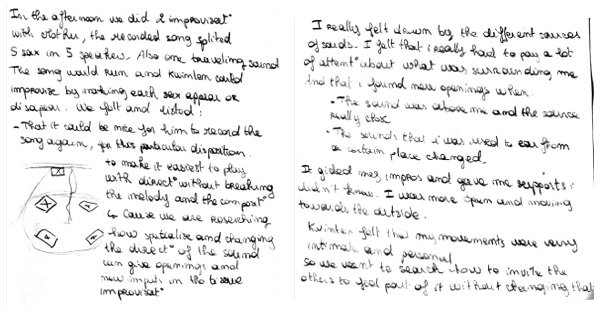
Noémie noticed that there were a lot of movements in the music (especially with the spatial sound setup), and that she had to be careful to not be a slave to the rhythm and only follow the sound and the emotion that it gave her. How could she contrast and play with something that is fixed in a composition?
It led to another set of improvisations, that forced us to ask ourselves how to give focus to and space for each other, and how we can play with who is guiding vs who is following, even if it’s a recorded sound. We tried to find meeting points, to help to build a new composition where both would give space/focus and guide or follow.
Limits of our setup
Kwinten quickly noticed the problem with our setup: there was only a small sweet spot, where the sounds melts perfectly, and it was the center of the room, where the silks were hanging. For the research we decided to ignore this a little bit. Because we wanted to explore first what was possible with the setup and how this influences Noémie. Thinking about the presentation we had to open it up a little so that the audience could have a little bit of the feel of the setup. This wasn’t perfect and every audience member probably heard it differently.
In a perfect spatial speaker setup you can let your sound come from everywhere you want in a circle around you. But with just five speakers, the most obvious sound direction comes directly from the speakers. Putting a sound in the space in between those speakers is less obvious. This depends on the distance between the speakers, the quality of the speakers and the acoustics of the room, which all weren’t perfect. Kwinten could have spent some time to go deep into it and fine-tune the position of the speakers, to find better speakers, to search for the best software, but this would take a lot of technical time. That’s why for this research he decided to focus more on moving exactly from speaker to speaker instead of moving freely in the room.
Kwinten: Some extra findings about the speaker setup
>> When a constant kick drum playing 16th notes would move from one to the next speaker after every fourth kick, this adds a rhythmical pulse on every beat, without actually having to put some extra sound or accent on the “four to the floor”.
>> Although it requires more research or expertise to use this setup with an audience, the silks are great in combination with this setup because it can really hang in the middle. This is in contrast to film or theater where you can work with surround, but it would always be a stereo concept with some sounds coming from the side or back, because your visual focus is always towards one side of the room (the screen or the stage). With the silks the visual focus can be in the middle and it’s nice to be surrounded by sound while looking at the silks.
>> It was cool to record myself (saxophone or voice) on one side of the room and let it be played in a speaker on the other side and then add on that loop and also move that to another speaker. But because of the distance and the latency of the sound it was difficult to play together with myself.
Kwinten: For the quadraphonic setup I researched and listened to some music from Suzanne Ciani, a synthesizer player with a full hardware setup that could be a great inspiration for a setup of my own if I would go further in researching this.
How to go further in the movements melting
Regarding the question of how to give focus to each other, and how can we play with who is guiding and who is following, we experimented and found meeting points that we experienced separately or found improvising in the following days.
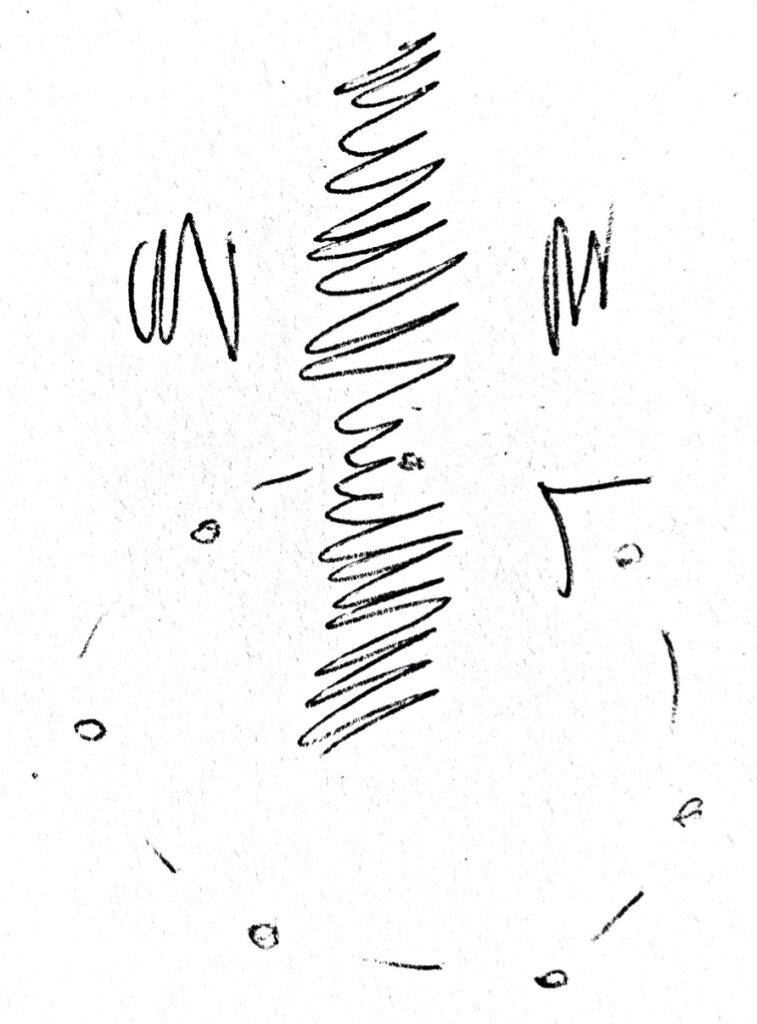
>> Shaking silks + trippy tornado: A nice counterpoint between shakes in balancing in silks and a mellow sound turning around the floor speakers
>> Music moving from down to up: wide (all boxes) to narrow (only up or one speaker),synchronized with Noémie climbing up fast as she was the trigger
>> A dynamic move from Noémie that would impact the movement or volume or dynamic of the music, or being a good stopping point
>> Unisson with tornado and Noémie turning or one is stopping and the other continues to turn
We also decided, at this point of the residency, to let a bit aside the song “Mother” and to have a live setup that could help us to react to each other, and could give Noémie more opportunities to lead the sound structure, having Kwinten reacting directly to what she was doing. Here also she had to really slow her moves to invite Kwinten to follow her more.
Improvising together
The live setup
Noemie’s movements have an interior quality. One question was how this setup could work with inviting the audience in an intimate experience. Along the way we found little answers to this big question. We started to work with half an hour improvisations, and we often went from dynamic sounds with beats and Kwinten’s voice to more wavy, calm sax and melodica sounds traveling slowly.
Accents
We also took a day to work really musically with accents, Noémie was having big body extensions on a bit, like she’ll go from a relaxed head down pike to a really active and horizontal body really quickly and drop it, and we tried to input that in the improvisations. We noticed these accents were having an exterior quality. With this exploration we worked in a really musical way, and with the same repetitive movement we were exploring the possibilities of creating music and really being on the music with Noémie’s movements. When noémie was really synchronized with the beat, Kwinten would stop that rhythmic element, so it would just stay in Noémie’s body, and he would start with a different one, that won’t alter Noémies movements for example. We also noticed that nice surprises could be made, by suddenly moving the accent of Noémie’s movement to another beat. During one improvisation Kwinten put one beat in each speaker except one, so we had one silence and Noémie was doing the big extension movement on the silence, that was really nice to fill the music like that.
Kwinten: For the research of rhythmical movement of Noémie and exploring how long we can hold a certain movement/musical idea, the spatial setup is not necessary. This could be a whole research on it’s own. This is also something I do a lot in my music. Repetition, building up but holding tension by not resolving towards anything. I feel this could be really interesting with silks and even with more ‘dancers’ and musicians. These ‘dancers’ could all subtly change their movements over time. Not per se a new concept in dance I think, but it felt somehow like maybe a new concept in silks? I think it’s especially interesting because there’s the concept of physical limits and risk that is very interesting in silks and that could be explored through endurance in this repetitiveness.
Noémie: The idea of repetitiveness was something that interested me and also really challenged me. I saw what we were researching, but in circus, at least in the way I learned and worked, I don’t count the music, and I felt my rhythmic knowledge was a bit limited for this experiment. So we went step by step with simple beats, and tried to add more complex layers. This, in addition to the physical limitations that you find when you repeat the same movement in the air for a longer time than I ever experienced, was a bit limiting for us to go deep in this repetition. During the last days, I did swings in the knot of my tissue in the same constant rhythm, and it gave Kwinten the opportunity to add layers of music. The result felt nice and made me wish to work longer on this concept.
Amplifications and resonances
We also spent a day working on amplifying little sounds. We recorded the sounds that the silks made when Noémie was shaking them. It was a really strange sound, but when we put it at the same time as the movement in the speakers and made them travel it was a really nice result, we played with that and tried to see different ways of making the sound appear, at the same time it gave a really intense storm. When Noémie stops shaking, but the sound continues it’s a nice counterpoint and it gives distance, we added a slow turning sound as well. It was a new tool for us to play with during the improvisations.
We also used a distortion effect on these shaking silks. This was also an interesting thing to do, having a more abstract representation. This gave a really heavy emotion. This could open some possibilities towards dramaturgy, by maybe letting this moment return a few times in a “show” but always with the sound differently processed according to the needs of the “show”.
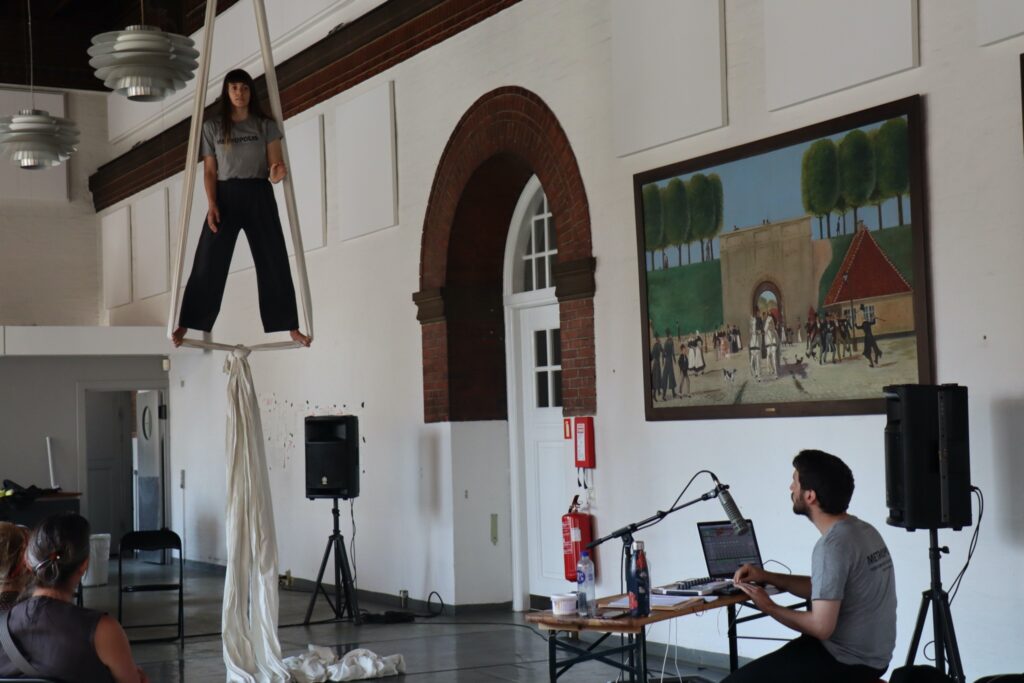
We also tried this recording and traveling with the sound of breaking the rosin, the powder Noémie uses to amplify the grip on the silks, and making it travel in the speakers. The idea was to have a tool to play with perspective and distance, like Noemie will be far from the public not in the circle breaking it in her hands and the sound will travel in the space like a whisper. We tried different combinations but it wasn’t that relevant in the improvisation process, and as we decided that we didn’t wanted to fix anything we didn’t use it a lot, but sometimes Kwinten added it when we were improvising and it was nice to stretch while this crispy sound was on, it gave a nice counterpoint.
Some of the experimentations we made in video:
Moving the speakers and not the sounds
We also tried to literally move the sound, by moving a speaker. The speaker was hanging from above to a rope so we could adapt the height during the movement and influence it. We stopped this research really quickly because of the setting in the room and the material that we had that was not optimal, but it was another door that we opened.
Adapt to the setup, being less chatty
During our research it became clear that both the movements and the music had to adapt to this setup. It became especially clear that the combination of all the layers meant that we could stay with one idea/movement/speaker/melody/… longer then when it would be seperate. This was clear from the beginning, but not easy to carry out, we also found again this trouble in our improvisations. Our second mentor, dancer and choreographer Kitt Johnson, who came the second week, pointed that out and we worked together one morning on this specific “let’s give more space to each other and use one sound or movement quality longer” in the improvisation process. For example during improvisations it was nice that if the room is at one moment filled with music, to go to almost silence and the sound lingers on in our heads. It was also nice when Noémie stayed in the same basic movement for a long time and let music play on it. It was hard for us to arrive at that point where you don’t produce too much information anymore and let the other take place, even if it’s something we wanted.
Kwinten: Since we moved from composing to improvising, I would’ve liked to have brought some other instruments, with which I would have a little bit more freedom. Now I made a little setup with my computer which was new to me. I usually improvise more with some hardware synthesizers. Of course translating this to a spatial setup would need some thinking, research and maybe buying some extra mixers.
What we found at the end
We think that what we found in this encounter and in this research is vocabulary. We started with an idea, and with figuring out how to work together, and that led us to explore during improvisations and in finding tools to improve them. We listed things that we liked, and that we can use as meeting points. We decided that it wasn’t relevant for this research to try to fix anything, so for the last days and our presentation we decided to improve and go deeper in the improvisations to specify our common language. The improvisations gave us glimpses of what this combination could lead to. It was nice to have the time and space to explore as many possibilities with this and to open a lot of boxes.
Kwinten: In working with Noémie I was reminded that other people listen to music very differently. She referred to “Mother” as a complex piece of music and she felt like at times she had nothing to add, because this would create too many layers, while I felt like an extra layer could add a very interesting contrast for example. This is an interesting insight, because in an audience there’s probably also both opinions and that’s maybe something that in a “show” would need some buildup so as not to lose some audience members from the start.
We have the feeling that if we were going to see eachother again for another residency we could:
>> Start creating and writing something, playing together with giving surprises to each other. With the work on repetitiveness we touched that in some improvisations but we didn’t go so far with it. We were touching and could have installed games of who will give up first, and really push to the limits of who is leading, the body or the music, and search new material or where it could have led us.
>> Think of a dramaturgy and maybe moments where there is just music, or just silence and circus.
>> We could also try with more speakers, to explore other ways to make the sound move, more height and really organise the room including the place of the public for a better listening/viewing experience.
>> Noémie: I also had the idea of a blind circus show that could be developed with a surrounding of voices, sounds and music, and people closing and opening their eyes. I was wondering how can we transcript a circus show with all the emotions that it gives in a small sound and visual installation in a non circus dedicated space.
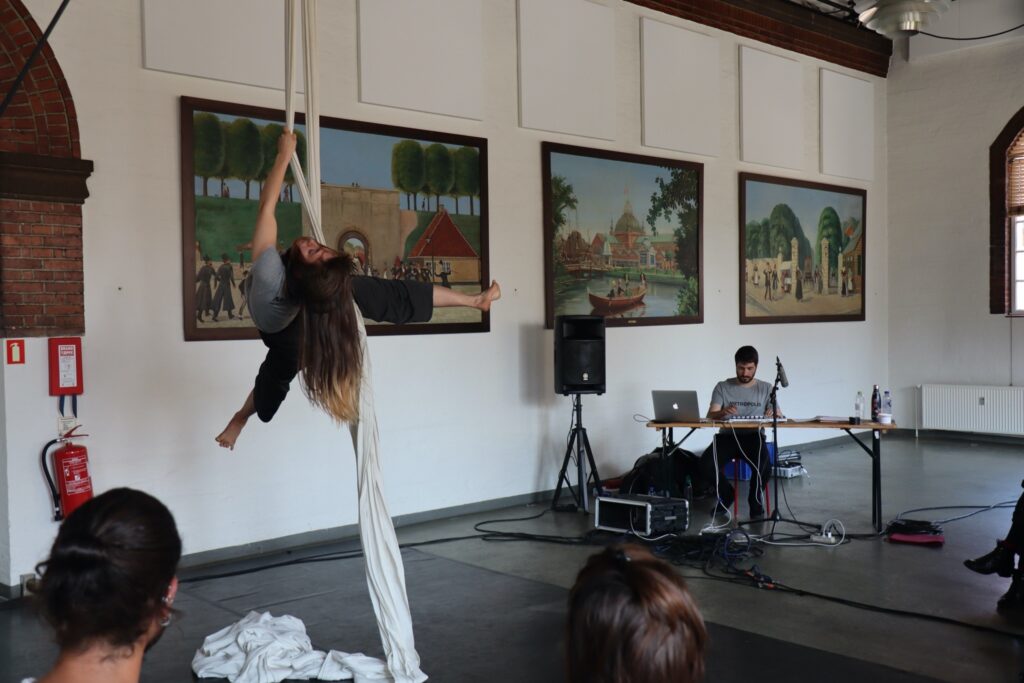
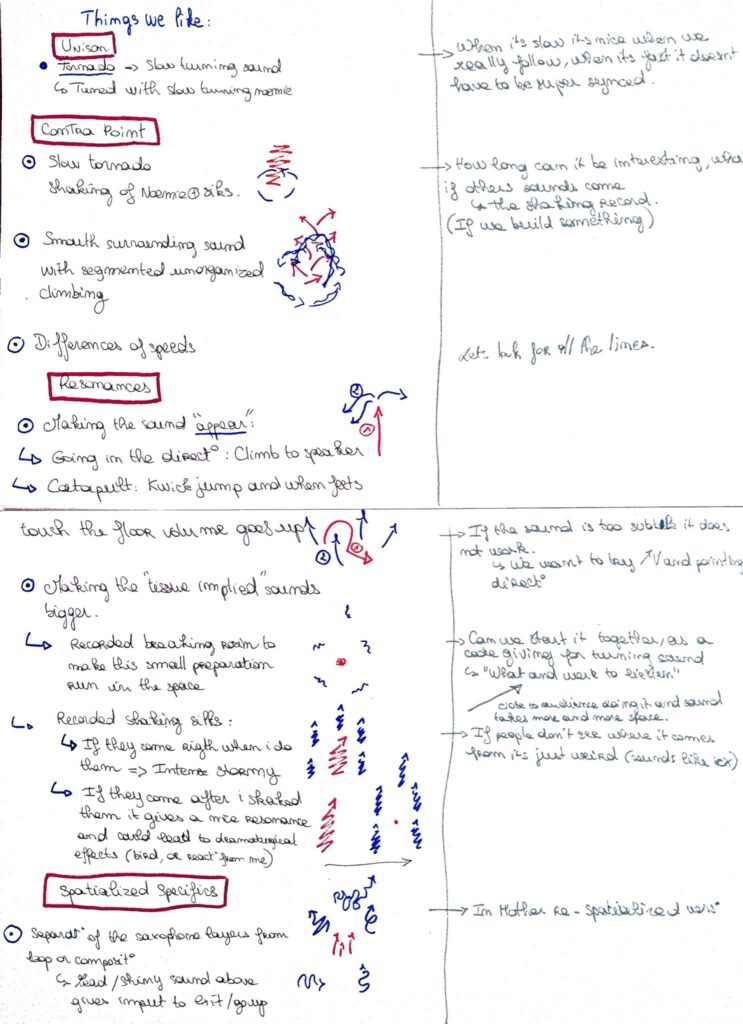
Inspirations
Videos:
Strange Meeting in an empty space – Stéphane Kozik and Julia Hadi:
Flock of vultures synchronized with electronic music (partly live? Or is this overdubbed). After a while Stéphane and Julia join the vultures. This creates a nice tension. Relevant for our research if we want to research the synchronicity between recorded sound and live movements.
Kasper T. Toeplitz – Inoculate?
https://alamuse.com/cds/inoculate/
Electronics, trombone, trompet, sax + dancer
We like the slowness of the dancer. We think we want to experiment with melodic/poëtic music in our research. We do like that in these long notes and sounds you can imply some wind or surroundings. This might be an interesting element too.
Installations:
Kwinten saw this instrument/installation in Brussels:
http://www.meakusma-festival.be/artist/modular-organ-system-v/
https://ovalspace.co.uk/blog/2017/5/efdemin-introduces-his-new-modular-organ-project
It’s a pipe organ with all different pipes spread around the room, which was really cool and overlapped with our idea of many speakers, because everywhere you walked you heard something different.
Noémie saw this Janet Cardiff’s installation in Paris
What I found inspiring was the movement created by the spectators that were moving in the space to hear each different voice coming from specifics speakers in the room like a secret while the song was running.
